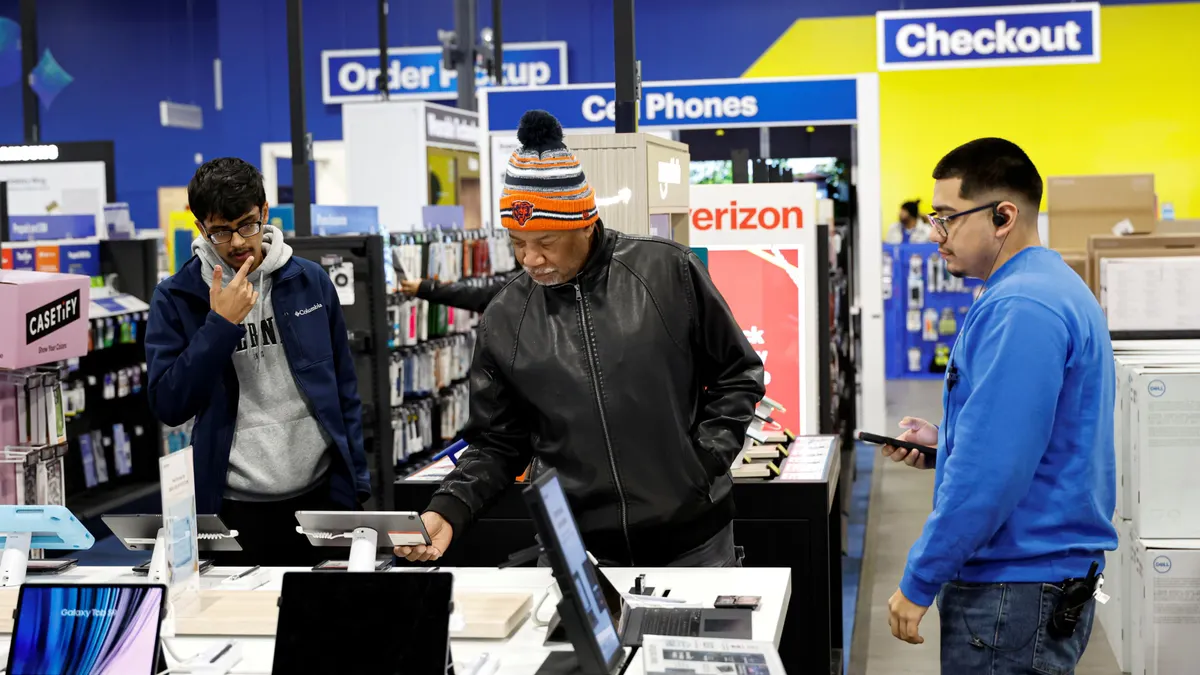What a year it’s been already. From a trade war to new developments in agentic AI, businesses are scrambling to react to a shifting business environment and increased competition.
Consumers’ worry about the state of the economy has them shopping around — willing to forgo loyalty for the best price. Businesses, too, are concerned about their budgets, and CX teams will have to demonstrate their value to keep investments flowing.
Some companies are paving the way with AI chatbots, but even those pioneers are struggling with balancing the role of human customer service agents and AI amid generational differences and a general distrust of the technology.
As we look ahead to the remainder of the year, what are CX leaders up against? CX Dive broke down the top challenges and what some are doing to meet them.
What will happen to consumer sentiment and loyalty as the economy quakes?
For months, consumers have been plagued by economic uncertainty. The Trump administration’s trade war and the threat of AI taking over jobs have disrupted consumer sentiment and shaped shopping behaviors.
A majority of consumers cite higher prices as their No. 1 concern, followed by unpredictable price increases, a Wunderkind survey from earlier this month found.
In the second half of the year, those trends will persist and deepen as more tariffs take effect and companies hike prices, according to Kate Muhl, VP analyst at Gartner.
“Consumers are feeling, in general, overwhelmingly negative about the policies themselves, and in general, do not feel bullish about where things are heading,” Muhl said.
Most of the consumer behavioral and attitude changes thus far are in reaction to uncertainty, Muhl said. But in the second half of the year, customers will be reacting to real price changes, either because companies that have already experienced tariffs can no longer absorb those costs and will pass them on to the consumers, or because companies are getting hit with fresh tariffs.
“What we're starting to see emerging are a set of spending behaviors that I would put under recessionary behaviors,” Muhl said.
Consumers are looking to save money. Gartner research shows that people are increasingly eating at home, sticking to a budget when they go shopping, and participating in dupe culture in which consumers take pride in finding knockoffs at a fraction of the price. They are also seeking deals more often, buying fewer non-essential items, and shopping less overall, according to the Wunderkind survey.
Consumers are also more willing to switch brands. That doesn’t mean that they won’t still have brand preference, but price might play a bigger role in some purchasing decisions, Muhl said.
“It's my preference is to buy this brand I'm loyal to, but if I've got the coupon for the other one and I have to stay within my price boundaries, I've got to be relentlessly prioritizing,” Muhl said. “So it might be that I don't care that much about laundry detergent, so though I have a brand I'm loyal to, sometimes I'm going to go on price.”
As businesses deploy agentic AI, where do humans fit?
While the full impact of agentic AI is likely still years off, the technology is already making its mark on contact center headcount and job responsibilities.
Many consumers lack trust in AI agents, and even those open to the technology lack familiarity with how it works. As a result, contact centers need to be prepared to help customers learn to use their newest self-service options in the short to medium term, Brian Cantor, managing director of digital at Customer Management Practice, said.
Live agents now have to field questions about how a new agentic chatbot works or whether they can trust it with personal information, according to Cantor. These inquiries will appear in addition to traditional customer service topics about payments, returns and similar topics.
In time, as the technology matures and customers become more familiar with how it works, the job of the customer service agent is expected to change. With AI handling simpler problems, humans will focus on more complex tasks — which will likely mean smaller teams.
“Inherently, there are fewer complex tasks than there are simple ones,” Cantor told CX Dive. “If you're going to say our agents are still going to be 100% support, but they're going to support a smaller set of issues, you are effectively saying that headcount will be reduced.”
Some businesses are looking into changing the role of customer service, according to Cantor. With AI taking over simple inquiries, live agents can focus on customer retention and sales.
One example is Klarna, which brought humans back into customer service a year after going all in on AI. In the process, the company reimagined the customer service agent job into a “role that blends frontline excellence with real-time product feedback,” Klarna spokesperson Clare Nordstrom told CX Dive earlier this year.
While this pivot makes sense, it won’t necessarily leave contact center teams unscathed. The profile of a good salesperson differs from the qualities that make a good customer service agent, and leaders will likely change their hiring and training practices to match.
Even if companies alter the nature of customer service in response to agentic AI, potential cost savings will be a factor in the rollout of the technology, according to Cantor. Leaders that want to maintain their employee headcount need to start strategizing about the role human agents will play.
“You could find yourself in a scenario where even if you have the best intentions, you may have no choice but to reduce headcount because you haven't planned ahead,” Cantor said.
Tariffs are hitting business budgets, too. Can CX teams prove their value?
Consumers aren’t the only ones concerned about the economy. No one can measure the exact impact of tariffs will have on budgets in the second half of the 2025 and into 2026, but teams will likely want to present a case for why CX is worth the investment.
CX often receives lower priority than short-term objectives even outside uncertain economic climates, according to Leah Leachman, senior director analyst at Gartner. A clear goal between experience and commercial goals is essential to earning CX initiatives their due.
“I don't know that there's going to be a definite answer on where budgets will go, but I think the scrutiny under which every decision you make is going to be higher and higher in terms of, ‘How do I deliver value internally to my business partners and consumers?’” Leachman told CX Dive.
Proving the value of CX requires more than reporting out high-level relationship metrics like NPS or CSAT, according to Leachman. Leaders need to present how experience is leading to more customer referrals, boosting customer lifetime value, or having other positive impacts on the bottom line.
“That takes the team really thinking about how are we prioritizing and how are we measuring success along the way, so we're not caught flat footed and can't answer these questions about why our efforts are contributing to the business,” Leachman said.
One place to start is working with analytics teams to examine customer satisfaction or other CX measurements to see if they have a correlation with operational and financial outcomes, according to Leachman.
Internal partnerships are a matter of trust between teams, and one good way to build them is to treat other departments as customers as well as colleagues. CX teams have access to valuable customer insights other business units might want.
Potential questions to ask include “What are your KPIs?” and “How can we enable you by better providing you with insight and transparency into the customer so we can help accelerate your goals?” Leachman said.
Once CX teams connect their metrics to business outcomes, they need to present their findings to other leaders in a way that aligns priorities to the broader goals of the company.
“How can we show that this aligns with the business objective and really highlight the relevant metrics that bring that story to life?” Leachman said.






















